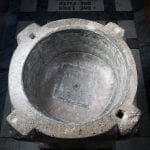Table of Contents
Even Stones Tell Stories
- The Norman font on marble paving donated in 1910 by George Henry Mildmay Ricketts C.B., a descendant of the Harris family of Silkstead.
- The Norman font carved from a single block of Purbeck marble.
- Detail of lead-lined interior
- Detail of fossil content
- Oak cover showing the carved inscription which continues the quotation from Ephesians 4 begun on the marble floor.
All Saints Church Font; how old is it and where is it from?
The bowl of the font in All Saints Church Compton is square in shape, rather crudely chiselled, and without decoration. It is almost certainly Norman in age and is probably contemporary with the construction of the church, which was completed in 1155 AD. So as the church font, it is at least 864 years old. We can only guess at the numbers of people who have been baptised here, perhaps as many as 8,000!
A comparable font, though with carved decoration, can be seen in the Church of St. Cross in Winchester; it is thought to have been originally in the nearby Parish Church of St. Faith (demolished early 16th century).
The All Saints font is made from a single block of Purbeck Marble, and the abundant fossil content can be seen when the font rim is moistened and polished (see photo).
Purbeck Marble is a hard, dark limestone composed of the shells of small extinct freshwater snails (Viviparus carinifera). It is of Berriasian (Lowermost Cretaceous) age: 140 million years ago! Purbeck marble is still quarried in the area to the west of Swanage, in the Isle of Purbeck, Dorset.
It is not a true marble, but the term “marble” as loosely used by quarrymen and masons can refer to a dense limestone that can take a polish. Purbeck marble occurs in three thin beds never more than four feet in thickness. It was important in medieval architecture as a decorative stone for fonts, monuments, paving and pillars. Examples can be seen in polished thin pillars in the Retrochoir of Winchester Cathedral and in the Great Hall of Winchester Castle.
Sarsen stones – such as the one you can see low down in the north wall at the west end of the “new church” – are blocks of indurated (hardened) sandstone (also known as silcrete) found sporadically on the chalk outcrops in southern England. They probably represent the remnants of the fluvial sand deposits of Tertiary age that once covered the chalk in this area. They were probably cemented by silica precipitation just below the ground surface. At the end of the last Ice Age, the surrounding un-cemented material was eroded away and the solid Sarsen stones washed into the developing valleys. The best examples have been used at Stonehenge and at Avebury Ring. The “ancients” often thought them magical and used them as worship centres.
It seems likely that some “Sarsen” stones rested in the Compton valley and were used as foundations for the Saxon Church and subsequently in the walls and foundations of the Norman Church. An example can be seen in the outer south-west wall of the Norman Church (north-west wall of the 20th-century nave.) Similar stones underpin the tower of St. Mary’s Church, Twyford, and examples of sarsen stones can be found in the valley side between the church and the river.
If you want to know more about All Saints Church, come along and meet us; you will be welcome. You may also like to purchase “A short guide to the church and its history” for a donation of at least £1. Excellent colour photographs by Adrian Walmsley. Available from Adrian or John Wilkinson or directly at the church.
JOHN WILKINSON. LOCAL HISTORY SOCIETY
(with thanks for the expert assistance from Dr John Parker, a Cathedral geologist.)
[Editor’s note: the text above appeared in the March 2019 issue of the Parish Magazine}Marble Floor
After the major project of extending the church was completed in 1905, further improvements were added over the next few years.
Churchwarden James Atkinson Pearson donated the 1906 East window by Kempe which depicts Christ in glory as the True Vine, surrounded by saints. In 1907 a new organ was installed.
In 1910 the font was moved into a better and more westerly position in the old church. It now stands surrounded by marble paving given by George Mildmay Ricketts, C.B. a descendant of the Harris family of Silkstede.
Oak Cover
[With thanks to the Hampshire Record Office archive, reference 1M76/PZ8/28]Rector’s Notes from the June 1961 Parish Magazine
The offer of the gift of an oak font cover has been accepted with appreciation by the P.C.C. and a faculty will shortly be sought for the work to be put in hand, together with a bronze grille to cover the unsightly radiator nearby.
The proposed work is to the design of Mr. Charles Burford, A.R.I.B.A., of Messrs. Carpenter-Turner and Burford.
The cover is both simple and graceful, and its only ornamentation is to have carved round it the text “One God and Father of all” – in completion of the verse from Ephesians iv inlaid in the marble flooring.
With this, a faculty will also be sought for the gift of the pair of 18th century brass candlesticks which were exhibited on the altar of the old church for a Sunday last summer, and for which a cross has been designed in keeping by Mr. Michael Murray – whose processional cross for the new Guildford Cathedral has lately attracted interest.
E. G. D. F.
George Fawkes, Rector 1958-73









